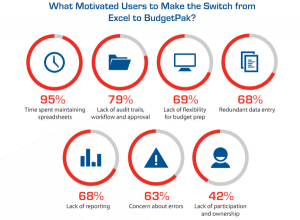Budgeting, planning and forecasting are “mission critical” applications in most organizations today. A poor budgeting process is the number one reason why organizations miss their numbers. Implementing a process that appeals both to the financial organization, officially responsible for the budget, and the department heads, who own the results is hugely difficult. Poor capabilities from ERP systems have caused most organizations to rely heavily on Microsoft Excel for budgeting, planning and forecasting. But Excel is a simplistic two-dimensional spreadsheet versus a product with built in “budget intelligence”, is not a product development environment, is not a database and therefore requires much manual data management and is not flexible enough to deal with the budget preparation needs of the actual users.
So, organizations, and the financial professionals in them, are now seeking solutions to this Excel dilemma. They want a sophisticated application that appeals to the department heads and allows them to spend their time analyzing the numbers, not programming or managing data or checking for errors or manually keying data into shadow spreadsheets.
A survey was recently conducted on these organizations and seven fundamental reasons surfaced as to why organizations made this critical switch to a best-of-breed solution. These issues were:
- Time spent maintaining spreadsheets
- Lack of budget audit trails, budget workflow and budget approval process.
- Lack of proper user interface and flexibility in budget preparation process for department heads
- Redundant data entry into multiple spreadsheets
- Lack of flexible reporting for the budget process and the management reporting process
- Concerns about errors in the budget process due to clobbering formulas or data entry or other issues
- Lack of participation in and ownership of the numbers by department managers.
The solution to this issue is an application specifically focused on the budgeting, forecasting and reporting process. Key criteria in selection of a system are:
- Cloud-based computing to minimize cost and IT involvement and to increase flexibility
- Focus on a user interface that appeals to the department heads. This is more of a Turbo-Tax like approach to organizational budgeting and away from Excel look-alike products
- Specific functionality to build a budget that lets department heads budget their departments the way they think about their departments
- A system that is simple to install and maintain that does not require programming or syntax or special knowledge
- Simple integration with key transaction systems like the GL, payroll or HR system, and fixed asset system
- Software acquisition costs (keep at a minimum)
Of these capabilities the key recommendation of people in organizations who licensed a new budget process was to focus on the needs of 95% of the users of budgeting…the department heads. A recent WSJ article on business software supported this idea. In it, the author writes:
“At a time when people are accustomed to using well-designed applications from companies such as Google Inc. and Apple Inc. in their personal lives, they have little patience for workplace applications that leave them confused. Functionality is no longer the definition of success. Usability is key.”
And here’s what one client recently said about the usability of XLerant’s BudgetPak solution:
“Creating spreadsheet budgets is not the best use of our finance team’s time, but until we found BudgetPak, it was necessary. Our team was able to master the budget set-up tools in BudgetPak with very little training and with the XLerant product in place, we can now spend time focusing on higher value tasks. What we love about XLerant is it gives our managers the tools to transform their department-specific knowledge into a budget they can understand and own.”
Read more of what clients have to say about BudgetPak
When it comes to technology…Keep It Simple Stupid. This is especially true if you need to get the buy-in from non-financial people in the process.


